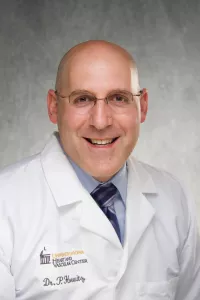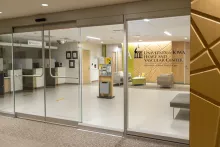Atrial Septal Defect (ASD)
- For all other requests:
- 1-800-777-8442
ASD symptoms and diagnosis
An ASD is an opening in the atrial septum, a wall of tissue separating the two upper chambers of the heart. ASDs are present at birth but often aren’t detected until adulthood.
Why ASDs need to be closed
A small ASD might never cause an issue. They’re often found during an unrelated medical examination.
A large ASD allows too much blood to enter the lungs, which overworks the heart and causes it to weaken. Symptoms can include:
- Shortness of breath
- Fatigue
- Decreased ability to exercise
- Irregular heartbeat (arrhythmia)
- Stroke
- Fainting
An untreated ASD can lead to heart failure or pulmonary hypertension.
How we diagnose ASDs
If you’re having symptoms or your doctor hears a heart murmur when examining you, you may need diagnostic tests that include:
- Echocardiogram
- Chest X-ray
- Electrocardiogram (ECG)
- Cardiac MRI
- CT scan
Your care team
A team of heart experts will examine you and review your test results. They work together to determine whether you need an ASD closure and whether a minimally invasive procedure is right for you. If it is, they’ll choose an ASD closure device that fits your unique anatomy.
Your care team will include:
- Interventional cardiologists with specific training and experience in structural heart disease
- Heart surgeons
- Specialists in cardiac imaging
ASD treatment at the UI Heart and Vascular Center
The most common type of ASD can usually be repaired with a minimally invasive procedure, but some types require open-heart surgery.
Minimally invasive closure
A cardiac catheterization procedure for ASD places a special device that closes the hole.
- You’ll receive a sedative to relax you, but you will remain awake during the procedure.
- After numbing the skin with a local anesthetic, your cardiologist will make a small incision in a vein near your groin and insert a tube called a catheter into the incision.
- Your cardiologist will thread a small ASD closure device through the catheter and into your heart and place it in the hole to close it. Tissue will eventually grow over the device to further seal the ASD.
- You’ll remain in the hospital for a few hours and perhaps overnight.
- You may be prescribed a blood thinner to take for a few months after your procedure.
- Your cardiologist will let you know when you can get back to your normal activities. Most people return to work in about a week, but you’ll need to limit your activities for several weeks.
After initial follow-up, you’ll have a yearly appointment with your cardiologist for ongoing monitoring.
Open-heart surgery
Minimally invasive ASD closure might not work for you if you have:
- A very large ASD
- An ASD in an unusual position
- Multiple heart defects
In that case, your team may recommend repairing your ASD through open-heart surgery.
This surgery is performed while you’re asleep under general anesthesia.
- Your heart surgeon will make an incision in your breastbone for access to the heart.
- You’ll be placed on a heart-lung bypass machine, which pumps blood through your body while your heart is stopped temporarily.
- Your surgeon will make an incision in your heart near the defect. They’ll stitch a patch, made from your own tissue or synthetic material, over the hole to close it.
- Your incisions are closed with sutures and the bypass machine is removed.
- You’ll be monitored in the intensive care unit after your surgery. It’s likely that you will have a breathing tube for a few hours.
- Recovery time is different for everyone. You may be in the hospital for five to 10 days, and gradually work your way back to normal activity over the next few months.
- Your cardiologist might recommend cardiac rehabilitation to help you recover.
Our Care Team


Has your doctor referred you to have your ASD evaluated?
Locations and Offices
